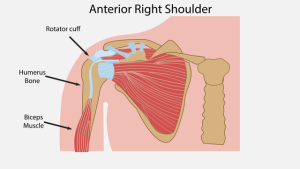Loggers and Rotator Cuff Injury
By Brie Weisman, OTR/L, with assistance from Michaela Marden, OTR/L
Also published in The Logger’s Voice Spring 2022
Shoulder injuries may not be the first thing that comes to mind when contemplating the dangers faced by loggers, but it only takes a moment to realize why they are commonplace in the industry. Tasks like pitching a strap over a load, and putting on tire chains can put great strain on the shoulder at awkward angles. Other tasks involving repetitive motion cause wear and tear. Beyond the work itself, logging environments can be snowy, muddy, or uneven terrain full of trip hazards that cause falls, a major cause of shoulder injuries.
 An unusual joint, the shoulder is one of only two ball and socket joints in our body, allowing for exceptional rotation (the other is the hip). But the shallowness of the shoulder socket leaves it especially vulnerable to injury, particularly the rotator cuff. The rotator cuff is a series of muscles in the shoulder that form a “cuff” of tissue around this ball. A rotator cuff injury is the result of a tear in a portion of this muscle group. Someone experiencing general shoulder pain, weakness, and/or loss of range of motion, especially with overhead movement or external, extended rotation, is very likely suffering from a rotator cuff injury.
An unusual joint, the shoulder is one of only two ball and socket joints in our body, allowing for exceptional rotation (the other is the hip). But the shallowness of the shoulder socket leaves it especially vulnerable to injury, particularly the rotator cuff. The rotator cuff is a series of muscles in the shoulder that form a “cuff” of tissue around this ball. A rotator cuff injury is the result of a tear in a portion of this muscle group. Someone experiencing general shoulder pain, weakness, and/or loss of range of motion, especially with overhead movement or external, extended rotation, is very likely suffering from a rotator cuff injury.
There are two main causes of rotator cuff tears: natural degeneration and injury. With aging, comes the degeneration of muscle tissues, creating heightened chances for rotator cuff and any other number of injuries, even in the course of everyday activities. In the young and healthy, an injury to the rotator cuff may happen suddenly when attempting to catch oneself with an outstretched hand during a fall, or by overexerting oneself, be it in a moment of great strain, or hours or even weeks of overdoing work especially new activities that the body is unaccustomed to. This is not an injury to be pigeon-holed; weight lifters, golfers, pitchers, and swimmers, all get rotator cuff injuries. Symptoms can vary in both detail and severity. If a tear is suspected, you should see your primary care provider for a comprehensive assessment.
Using ice and resting can go a long way in addressing a temporary injury versus making it a lifelong injury. A rotator cuff can be treated with surgery, but the shoulder area will always be compromised.
Preventing shoulder injuries is about working smarter, not harder.
- Use proper body positioning. Lift closer to the body rather than with outstretched arms.
- Maintain good posture. Truckers suffering from fatigue should take care not to slump forward or round the shoulders.
- A properly fitted five-point harness can help with posture.
- Conserve energy. Use gravity to your advantage and take regular rest breaks, or break up a long task by alternating with other tasks.
- Reduce repetitive motion wear and tear. Something as simple as changing up the angle of pitching straps over a load is helpful.
- Keep abreast of changing technology in logging. Simple things like changing over to newer, lighter straps to reduce stress on shoulders can mean an injury avoided.
These small adjustments to daily work and being proactive in addressing pain can make a big difference in reducing risk of serious and painful shoulder injuries. A good stretching routine and moderate strength training exercises are crucial to keeping the shoulders and other joints ‘well oiled.’ Ask your primary care provider for exercises or other recommendations.
There is an excellent YouTube video that answers other questions about shoulder injury management for log truck drivers created by British Columbia Forestry Council. Shoulder Injury Management for Log Truck Drivers, BC Forest Safety Council (YouTube).
